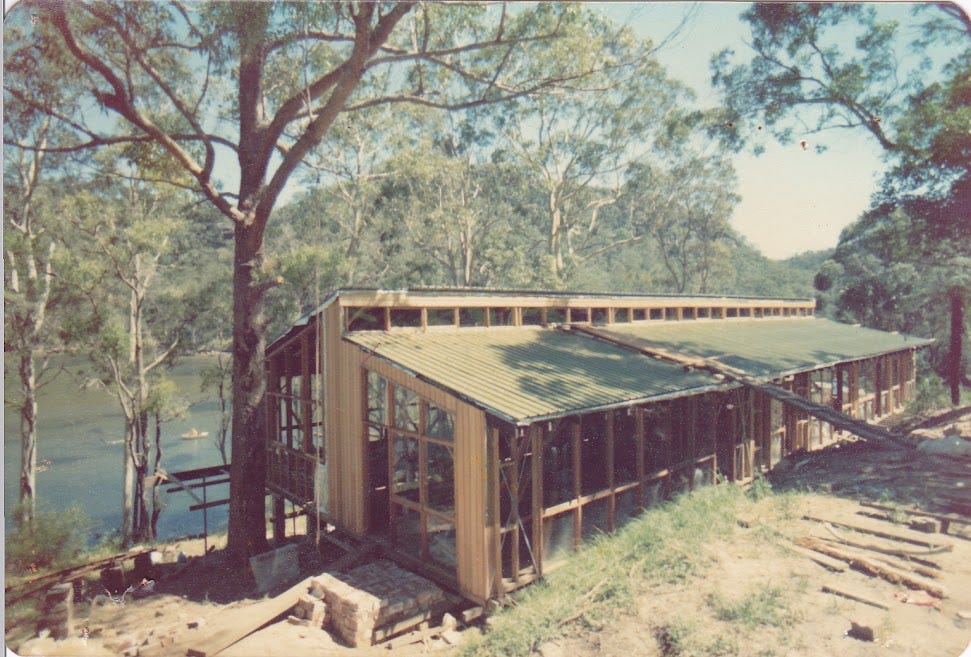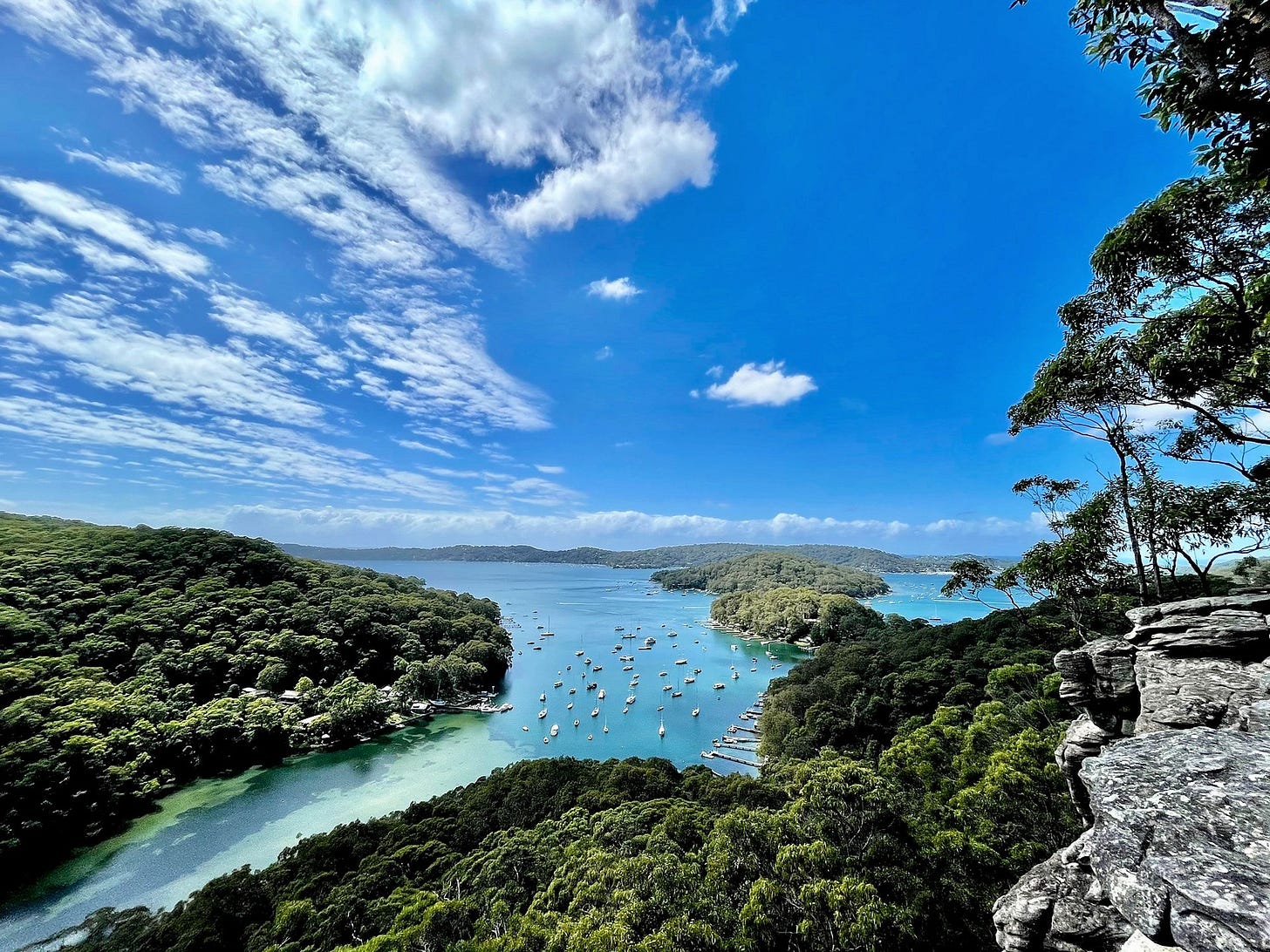Good morning Beloved Reader,
Below is the first serialized chapter from PART TWO of the book, The Rising of the Divine Feminine and the Buddhist Monks Across the Road: A Memoir by Camilla Sanderson.
If you are new to the story, you may read a description of the whole book at the bottom of the About Page or to read from the beginning you may go to the Table of Contents.
PART TWO braids two coming of age narratives: Camilla growing up in a home accessible only by water in Pittwater, Australia; and Jamie and Camilla young adulting in New York City 1990-1997.
This memoir was written before my father died at the beautiful old age of 86 in May 2022. I feel incredibly blessed that he had read early drafts which led to some truly meaningful conversations and healing between us.
April 2023 UPDATE: In October 2022, when I first began releasing serialized chapters of The Rising of the Divine Feminine and the Buddhist Monks Across the Road: A Memoir by Camilla Sanderson (yours truly), chapters were free to all subscribers. However, chapters are now released and available to read for free for one month after publication, after which they move behind the paywall. If you like what you’re reading and want to start from the beginning, I urge you to buy a subscription to keep reading.
I also provide other free content here.
To read a description of the book, please read the bottom of the post: An Invitation. You may also visit the Table of Contents.
Copyright © 2023 by Camilla Sanderson
All rights reserved. No part of this book may be reproduced or reprinted without the author’s written permission.
PART TWO:
"Remember how important it is to look at relationships not as a source for your happiness, but as a crucible for your own inner growth. They show you what your triggers are, and what you need to work on in yourself. The paradox is that once you accept that and do the inner work, then it’s those very relationships that end up adding to your happiness.
The common experience is that when we spend time with people we love, we often feel that we’re in the crucible and the fire is getting hotter and hotter. And this is the gift."
—Rev. Dr. Stephanie Rutt
Chapter 22. Pittwater, Australia 1978-1988
Gum-nuts in eucalyptus trees. Bright yellow wattle flowers. Banksia cones masquerading as ‘bad’ Banksia men, like in Snugglepot and Cuddlepie, a favorite childhood picture book where May Gibbs turned native Australian botanicals into whimsical characters adventuring in the bush. A Kookaburra laughs loudly from the branch of a Eucalypt, oooooo ooooo ooooo aaaaaaa aaaaaaa aaaaaa… similar to the sound of an ape in a jungle, in a Tarzan movie. A Kookaburra who laughs after it repeatedly whacks a small snake in its long beak, on the branch it sits on, to kill it, then eat it. Australian bush savagery set against a kookaburra’s laugh.
Kingfishers fly out low over the wide bay. A full moon brings King tides, with eight-foot tidal differences in front of our home. Radiant waters soothe me. Dreamy early-morning swims in the green and gold sparkling water of a King high tide in Lovett Bay. Deep enough that I can’t touch the sandy bottom. Not that I’d want to, for fear of stepping on a stingray swimming stealthily along, just an inch above the sand.
King low tide, and I walk across the bay. Vast expanses of exposed sand. I listen for the soft trampling sounds of pale blue-and-white soldier crabs marching across the sand flats, leaving telltale rounded pellets of discarded sand behind them. Mangrove roots poke up through the sand, smelling musky, dank, and salty. My three sisters and I run through the wide-open space, yelling and screaming with delight and wild abandon. Throwing boomerangs, playing Frisbee, playing softball using a small translucent jellyfish stranded on the sand, for a makeshift ball. Squish.
~
Now in my fifties and reflecting back upon where I was raised, I’m amazed by how my parents created a sacred space where their four daughters could run wild and free. An idyllic home set amongst the gum trees. A setting for an unrestricted childhood, with playmates in my sisters, Penny, Stasia and Misty. A space where we played outside, exploring the natural environment. A space to be relaxed, authentic, spontaneous and free.
But with parents who had irreconcilable differences—whose egos battled for power and control, leading to volcanic fights, and who didn’t, wouldn’t, or couldn’t understand each other’s perspective—they also created an underlying tension that permeated our dreamy, magical paradise. A setting ripe for childhood wonder and surprise, but that lacked parental harmony.
Their marriage ended in divorce when I was sixteen.
~
My father was a visionary—ironic really, as now, he has only one eye.
When Dad was forty-eight, he had cancer in his left eye. Radiation treatment gave him ten more years of decent vision before they had to remove his eye due to collateral damage from the radiation. In his thirties, even with both eyes, it was somewhat radical for him to be able to ‘see’ the possibility that it may be an enjoyable reality, to build a home that was only accessible by water.
Dad took a six-month sabbatical from his work at IBM and hired several university students to work as laborers to help him build a “kit home.” My mother had asked the manufacturers, “What can’t I change?” They told her, “the four outside walls.” But this did not stop her from transforming the outside walls into windows and wood-framed glass doors, each of which opened out to a deck that surrounded the entire house. Perhaps all the glass reflected my mother’s predilection to be so open and transparent.
With his hired student help, Dad built a long, ranch style, western red cedar home, for his wife and four daughters—actually three daughters at the time of building. The fourth was born there at home, in my parents’ bedroom, with a view down Salvation Creek. Misty’s placenta was buried beneath a gum tree right in front of their bedroom.
My parents found and bought this land in Lovett Bay, Pittwater, an hour north of Sydney in 1970, when I was three, and built our home there when I was eight.
The land surrounding Pittwater—37,000 acres of it—is national park, except for the privately owned lots along the waterfront. But before white settlers, this land had been occupied for many thousands of years by the Kuringgai Aboriginal people. They used the water as an important source of food and a place for trade. Their deep connection with the land is inextricably linked with the Dreamtime—the Aboriginal understanding of the world, of its creation, and its great stories. Perhaps it was the spiritual lay lines of the Dreamtime, embodied in the geography of Pittwater, that attracted both my parents to buy the land and build our home there.
The spiritual thread woven throughout the fabric of my life makes more sense to me when I consider the deep spiritual roots in the earth upon which I was raised; and the complex relationship each of my parents had with their own spirituality.
As a young English man living in London, Christopher—my father—was a fan of Ayn Rand’s philosophy of objectivism: “the concept of man as a heroic being, with his own happiness as the moral purpose of his life, with productive achievement as his noblest activity, and reason as his only absolute.”
When Jocelyn—my Australian mother—met Lady Sanderson, Dad’s upper-class English granny living in a posh apartment in Knightsbridge, she asked Jocelyn, “Has he told you about those wicked books he’s reading—all about how to be selfish?”
Lady Sanderson did not approve.
Ayn Rand’s four tenets of objectivism are: reality, reason, self-interest, and capitalism. But at the ripe old-age of 83, Dad has softened his stance. He lives in an “intentional community” in Byron Bay, Australia, and focuses his energy for the greater good through climate change activism. Perhaps he realized the limitations of the last two tenets: self-interest and capitalism.
When Dad was in his forties, married with four daughters, he was anti anything that had the slightest scent of religion. I don’t know why. He never wanted to talk about his background and his experience growing up in English boarding schools. Whatever I learned about his upbringing, I learned from my mother.
My maternal grandmother—born and raised in an Australian country town—frequently helped with raising us four girls. But when Nan tried to teach us the Lord’s Prayer, Dad told his mother-in-law, “We’ll have none of that in this house.” While he kept a strong anti-religion stance throughout his life, which I inherited, his crisis in health cracked open his heart and he began to ‘look’ at the possibility of a spiritual aspect to his human experience. In his late-forties, when diagnosed with cancer in his eye, he sought spiritual counsel from a controversial Indian guru—Bhagwan Shree Rajneesh, now known as Osho—the guru featured in the recent Netflix series Wild, Wild Country.
On a metaphysical level my mother believed my father’s cancer in his eye was connected with what he could not ‘see’ in his life. She hoped this Indian guru would help Dad to see both his own success, and the love in his life with his family. While this evolution of his consciousness would have been ideal, at that point in time, he did not evolve in the way that, perhaps, my mother wished he would.
Lovett Bay, Salvation Creek, Church Point. I sometimes wonder if the spiritual essence embodied in the names of the area, inspired my parents to purchase that land. Perhaps they already realized the fundamental problems in their marriage. Problems maybe originating from a clash of English and Australian cultures. Or maybe just incompatible personalities. Perhaps the word ‘salvation’ struck them on a subconscious level. Maybe they simply felt this peaceful setting would benefit a family life. Lovett Bay did allow us kids to thrive, but the underlying strain continued to play out in their relationship.
Click to read chapter 23.






❤️❤️❤️